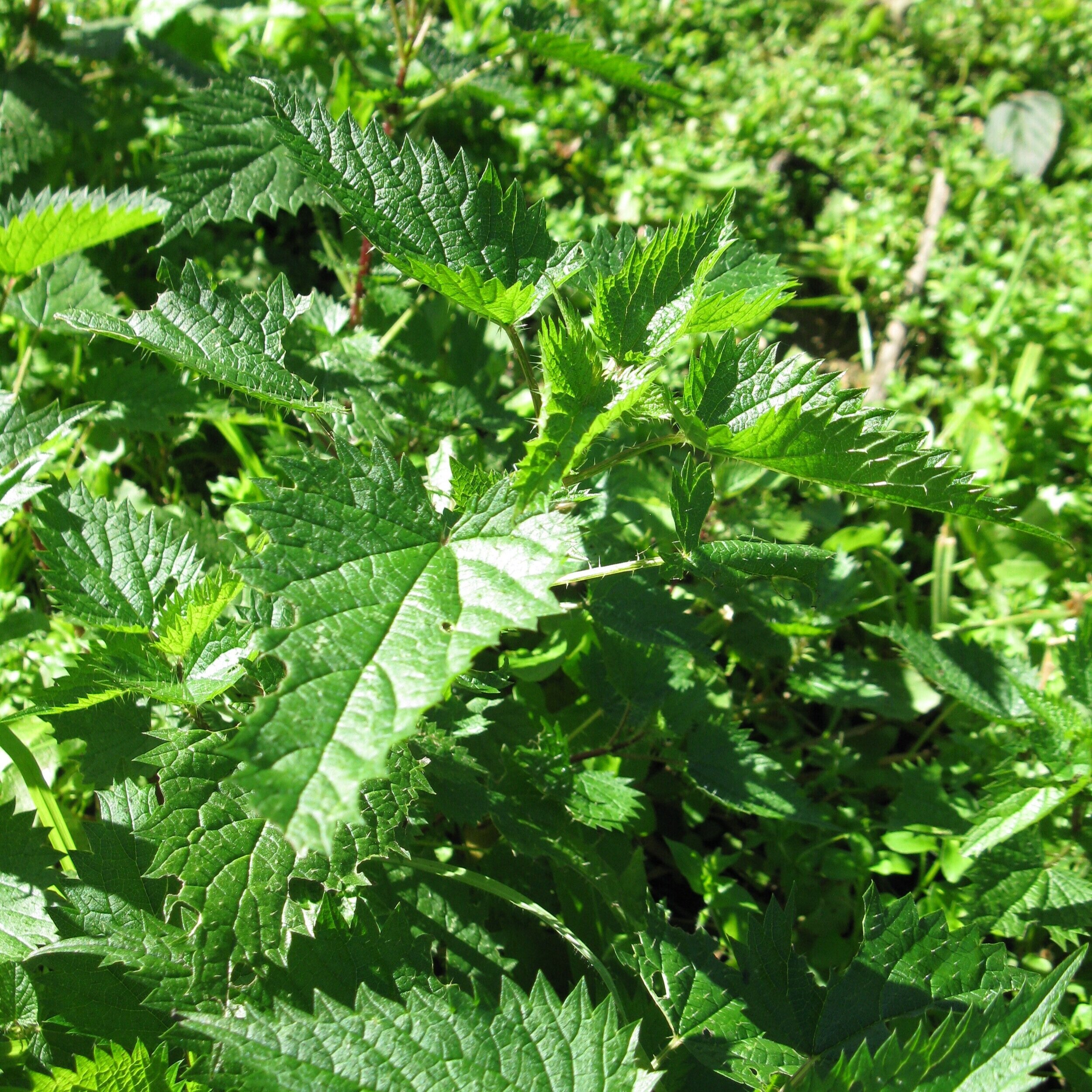Nettle: versatile plant and delicious ingredient.
Nettle is a brilliant plant with many different properties. This wild green is super nutritious, it can help improve your health and it can be used as weaving fibre. Thanks to its richness in vitamins and minerals, this plant can also function as a great boost to the soil it grows into. On the other hand, nettle can also be harmful if it comes in contact with your bare skin, so it’s always suggested to be mindful when foraging this plant.
**Caution**
Please note that nettle is covered in stinging hairs that cause painful skin irritation. Always wear gloves when engaging with this plant.
The reason why nettle leaves can cause rashes is due to the hollow prickly little “hairs” all over them. When these “hairs” piece the skin, a bulb at the base releases chemicals that will irritate the skin.
To avoid any type of skin rash caused by nettle, be very mindful and wear a pair of gloves. To be extra safe you can rub off the hairs from the plant with your gloved hands or alternately, you can boil, dry, or grill the harvested plant.
There are some methods that can help reduce the pain in case you accidentally touch nettle, and a rash appears. It is suggested not to touch the rush, because by doing so you can cause the chemical to sink deeper into the skin. Roughly 10 minutes after being in contact with the plant the chemicals will dry on the surface of the skin. To reduce the pain, after ten minutes, the skin can be washed with soap and water or just with a damp cloth.
I was stung so many times by this plant in my youth when I was working in the fields during summer. I would accidentally brush my leg against it, and within three to five seconds the itchiness of the sting would begin, quickly developing into a searing irritation that could persist for hours! It definitely kept me awake and alert while I was working.
How to make nettle string
Stinging nettle has been traditionally used in many cultures to make clothing and is regarded as a great alternative to cotton. The bark of this wild weed is also commonly used to create strings and ropes.
1. Forage the nettle wearing gloves and remove the leaves.
2. Rub the stem while wearing gloves to remove any of the stinging hairs
3. Soak the bark overnight to make sure all the stinging hairs are removed, and it is safe to touch
4. Gently tap the bark with a stone to flatten it
5. Once you remove the woody parts of the stem you are left with the fibre
6. Pull apart the fibre, fold it in half
7. Strat twisting!
You can follow this link to learn how to weave the nettle fibres correctly to create a firm string.
How to make cordage or strings using nettle fibre. Video tutorial on how to roll cordage.
How to identify nettle
Nettle is an erect, branched, perennial plant that follows a yearly cycle. It dyes off after seeding, to sprout back up with new growth when conditions are right. There are three varieties of nettle in Australia.
Giant nettle (Urtica dioica)
Although this variety is exotic to Australia it is naturalised all over the country. This plant grows to a height of 150 centimetres and has oval, or diamond-shaped leaves that are up to 10 centimetres long.
Small Nettle (Urtica urens)
Small nettle is also non-native to Australia but naturalised. This plant grows to a height of 60 centimetres. Its leaves are smaller than those of the giant nettle and grow up to 6 centimetres long.
Native nettle (Urtica incisa)
This variety can be found all over south-eastern Australia. The native nettle can grow to a height of 100 centimetres. The leaves are narrower compared to the ones of other species and grow up to 10 centimetres long.
Flowers and seeds
In all species, nettle’s flowers are small (1 to 3 millimetres across), white to cream in colour, and grow in short clusters that grow where the leaves emerge from the stalk. The flower clusters are 1 to 3 centimetres long in the Giant and Small nettle, and considerably longer (up to 5 centimetres) in the native nettle. The seeds mature late in summer and are often used in skin and hair care.
As Medicine
Nettle has a long history of use as a folk remedy and is commonly prescribed as an herbal supplement by naturopaths across the globe. Tea made from brewing nettle leaves has traditionally been used as a tonic and blood purifier.
Historically, the freshly foraged plant would be to treat arthritic pain, the stinging leaves were rubbed on the affected areas to activate the blood flow.
Nettle extract is also known to be an efficient folk remedy for the treatment of dandruff.
How to use nettle in your recipes
Nettle can be a very useful wild green to implement in your diet as it is extremely nutritious and easily digested. This wild food has a high content of minerals like iron and can be a great source of vitamin A and C.
Cooking the leaves, or thoroughly drying them, neutralises the stinging potential of the hairs and their chemicals, making the leaves safe to be consumed.
An Aboriginal friend of mine taught me a great camping hack with nettle. You collect the plant, stalk and all (use gloves or a rolled-up shirt) and place the branches on stones near a fire. They will cook in the heat, neutralising the sting and turning into excellent nettle chips. All you need is nettle, fire, and salt.
If you scroll down, you will find a recipe I developed with plant-based chef Joey Astorga for an event in country NSW– feeding stinging nettles to farmers. It was a hit!
Stinging Nettle Focaccia Recipe
Ingredients
8 cups fresh nettle leaves
2 teaspoons (1 x 7 g sachet) dried yeast
2 teaspoons caster sugar
3 cups plain flour
Olive oil for greasing tray and brushing focaccia
2 tablespoons fresh rosemary leaves
2 teaspoons sea salt flakes
Method
1. Blanch the nettle leaves in salty boiling water. Drain, then rinse in cold water. Remove any stalks, chop the leaves roughly and set aside.
2. Mix all the dry ingredients together in a large bowl. Make a well in the centre, then slowly incorporate 1¼ cups warm water and work into a dough.
3. Turn the dough out onto a floured surface and knead gently for 5 minutes.
4. Put the dough in a bowl that has been coated with a little olive oil. Cover with a clean tea towel and leave to rise for about 1 hour in a warm place (around 30°C is ideal, so on top of your warm oven is a good spot).
5. Knead back the dough, then add the blanched nettle and the rosemary. Keep kneading to fully incorporate the nettle. Let the dough rest for another hour.
6. Oil a rectangular, shallow tin (I use a 25 x 35 cm tin). Tip the dough onto the work surface, then stretch it to fill the tin. Cover with a tea towel and allow to rest for another 30 minutes. Preheat your oven to 200°C fan-forced or 220°C conventional.
7. Bake at 200°C for 10 minutes, then lower the temperature to 160°C and bake for another 5 minutes.
8. Remove the focaccia from the oven and leave it to cool for 5 minutes in its baking tray. Brush with a generous amount of olive oil, lightly sprinkle with sea salt, then remove from the tray and transfer to a wire cooling rack.
9. Serve with olive oil for dipping, or with your favourite spread, and enjoy.
DISCLAIMER: This information should be used as a guide only. It is not my intention to advise anyone on medical conditions, rather I'm just presenting a new way to look at the plants growing in your yard.
Let me help: if you are unsure about the identity of your plants tag me in a picture or comment below, and I’ll endeavour to help.
This article is one of the many that will be published in an upcoming book: Eat Weeds. Out in March 2022, get ready for it!
Resources:
https://bie.ala.org.au/species/https://id.biodiversity.org.au/node/apni/2887795
https://www.healthline.com/health/stinging-nettle-rash#homeremedies
https://forager.org.uk/resources/wild-food-blog/21-ingredients/96-eating-nettle-seeds
https://www.filson.com/blog/how-to/how-to-make-stinging-nettle-cordage/










